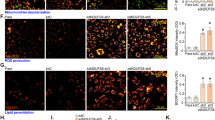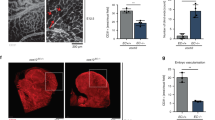Abstract
H2A histone family member X (H2AX, encoded by H2AFX) and its C-terminal phosphorylation (γ-H2AX) participates in the DNA damage response and mediates DNA repair1,2,3,4,5,6. Hypoxia is a physiological stress that induces a replication-associated DNA damage response7. Moreover, hypoxia is the major driving force for neovascularization8, as the hypoxia-mediated induction of vascular growth factors triggers endothelial cell proliferation8. Here we studied the role of the hypoxia-induced DNA damage response in endothelial cell function and in hypoxia-driven neovascularization in vivo. Hypoxia induced replication-associated generation of γ-H2AX in endothelial cells in vitro and in mice. Both in cultured cells and in mice, endothelial cell proliferation under hypoxic conditions was reduced by H2AX deficiency. Whereas developmental angiogenesis was not affected in H2afx−/− mice, hypoxia-induced neovascularization during pathologic proliferative retinopathy, in response to hind limb ischemia or during tumor angiogenesis was substantially lower in H2afx−/− mice. Moreover, endothelial-specific H2afx deletion resulted in reduced hypoxia-driven retina neovascularization and tumor neovascularization. Our findings establish that H2AX, and hence activation of the DNA repair response, is needed for endothelial cells to maintain their proliferation under hypoxic conditions and is crucial for hypoxia-driven neovascularization.
This is a preview of subscription content, access via your institution
Access options
Subscribe to this journal
Receive 12 print issues and online access
$209.00 per year
only $17.42 per issue
Buy this article
- Purchase on Springer Link
- Instant access to full article PDF
Prices may be subject to local taxes which are calculated during checkout




Similar content being viewed by others
References
Rouse, J. & Jackson, S.P. Interfaces between the detection, signaling and repair of DNA damage. Science 297, 547–551 (2002).
McGowan, C.H. & Russell, P. The DNA damage response: sensing and signaling. Curr. Opin. Cell Biol. 16, 629–633 (2004).
Fernandez-Capetillo, O., Lee, A., Nussenzweig, M. & Nussenzweig, A. H2AX: the histone guardian of the genome. DNA Repair (Amst.) 3, 959–967 (2004).
Celeste, A. et al. Histone H2AX phosphorylation is dispensable for the initial recognition of DNA breaks. Nat. Cell Biol. 5, 675–679 (2003).
Bassing, C.H. & Alt, F.W. H2AX may function as an anchor to hold broken chromosomal DNA ends in close proximity. Cell Cycle 3, 149–153 (2004).
Sedelnikova, O.A., Pilch, D.R., Redon, C. & Bonner, W.M. Histone H2AX in DNA damage and repair. Cancer Biol. Ther. 2, 233–235 (2003).
Hammond, E.M. & Giaccia, A.J. The role of ATM and ATR in the cellular response to hypoxia and re-oxygenation. DNA Repair (Amst.) 3, 1117–1122 (2004).
Carmeliet, P. Angiogenesis in life, disease and medicine. Nature 438, 932–936 (2005).
Hurley, P.J. & Bunz, F. ATM and ATR: components of an integrated circuit. Cell Cycle 6, 414–417 (2007).
Zhang, Y.W., Hunter, T. & Abraham, R.T. Turning the replication checkpoint on and off. Cell Cycle 5, 125–128 (2006).
Shiloh, Y. ATM and ATR: networking cellular responses to DNA damage. Curr. Opin. Genet. Dev. 11, 71–77 (2001).
Lopes, M. et al. The DNA replication checkpoint response stabilizes stalled replication forks. Nature 412, 557–561 (2001).
Hammond, E.M., Dorie, M.J. & Giaccia, A.J. ATR/ATM targets are phosphorylated by ATR in response to hypoxia and ATM in response to reoxygenation. J. Biol. Chem. 278, 12207–12213 (2003).
Hammond, E.M., Dorie, M.J. & Giaccia, A.J. Inhibition of ATR leads to increased sensitivity to hypoxia/reoxygenation. Cancer Res. 64, 6556–6562 (2004).
Gibson, S.L., Bindra, R.S. & Glazer, P.M. Hypoxia-induced phosphorylation of Chk2 in an ataxia telangiectasia mutated-dependent manner. Cancer Res. 65, 10734–10741 (2005).
Arjamaa, O. & Nikinmaa, M. Oxygen-dependent diseases in the retina: role of hypoxia-inducible factors. Exp. Eye Res. 83, 473–483 (2006).
Campochiaro, P.A. & Hackett, S.F. Ocular neovascularization: a valuable model system. Oncogene 22, 6537–6548 (2003).
Noguera-Troise, I. et al. Blockade of Dll4 inhibits tumour growth by promoting non-productive angiogenesis. Nature 444, 1032–1037 (2006).
Celeste, A. et al. Genomic instability in mice lacking histone H2AX. Science 296, 922–927 (2002).
Celis, J.E. & Celis, A. Cell cycle-dependent variations in the distribution of the nuclear protein cyclin proliferating cell nuclear antigen in cultured cells: subdivision of S phase. Proc. Natl. Acad. Sci. USA 82, 3262–3266 (1985).
Zou, L. & Elledge, S.J. Sensing DNA damage through ATRIP recognition of RPA-ssDNA complexes. Science 300, 1542–1548 (2003).
Economopoulou, M. et al. Inhibition of pathologic retinal neovascularization by alpha-defensins. Blood 106, 3831–3838 (2005).
Smith, L.E. et al. Oxygen-induced retinopathy in the mouse. Invest. Ophthalmol. Vis. Sci. 35, 101–111 (1994).
Alva, J.A. et al. VE-Cadherin-Cre-recombinase transgenic mouse: a tool for lineage analysis and gene deletionin endothelial cells. Dev. Dyn. 235, 759–767 (2006).
Bassing, C.H. et al. Increased ionizing radiation sensitivity and genomic instability in the absence of histone H2AX. Proc. Natl. Acad. Sci. USA 99, 8173–8178 (2002).
Luttun, A. et al. Revascularization of ischemic tissues by PlGF treatment, and inhibition of tumor angiogenesis, arthritis and atherosclerosis by anti-Flt1. Nat. Med. 8, 831–840 (2002).
Hammond, E.M., Denko, N.C., Dorie, M.J., Abraham, R.T. & Giaccia, A.J. Hypoxia links ATR and p53 through replication arrest. Mol. Cell. Biol. 22, 1834–1843 (2002).
Hammond, E.M., Kaufmann, M.R. & Giaccia, A.J. Oxygen-sending and the DNA damage response. Curr. Opin. Cell Biol. 19, 680–684 (2007).
Huang, L.E., Bindra, R.S., Glazer, P.M. & Harris, A.L. Hypoxia-induced genetic instability—a calculated mechanism underlying tumor progression. J. Mol. Med. 85, 139–148 (2007).
To, K.K.W., Sedelnikova, O.A., Samons, M., Bonner, W.M. & Huang, L.E. The phosphorylation status of PAS-B distinguishes HIF-1α from HIF-2α in NBS1 repression. EMBO J. 25, 4784–4794 (2006).
Orlova, V.V., Economopoulou, M., Lupu, F., Santoso, S. & Chavakis, T. Junctional adhesion molecule-C regulates vascular endothelial permeability by modulating VE-cadherin–mediated cell-cell contacts. J. Exp. Med. 203, 2703–2714 (2006).
Gerhardt, H. et al. VEGF guides angiogenic sprouting utilizing endothelial tip cell filopodia. J. Cell Biol. 161, 1163–1177 (2003).
Lin, M.I., Yu, J., Murata, T. & Sessa, W.C. Caveolin-1–deficient mice have increased tumor microvascular permeability, angiogenesis and growth. Cancer Res. 67, 2849–2856 (2007).
Acknowledgements
This research was supported by the Intramural Research Program of the US National Institutes of Health National Cancer Institute. H.F.L. was supported by the German Academy of Sciences (Leopoldina). We would like to acknowledge M.E. Kruhlak for the help with microscopy, D. Winkler and S. Kaul for help with genotyping, G. Tosato for help with Matrigel experiments, F. Alt (Harvard University) for providing the H2afx floxed mice and A. Singer and D.S. Singer for critically reading the manuscript.
Author information
Authors and Affiliations
Contributions
M.E. designed and conducted experiments and wrote the manuscript, H.F.L. conducted experiments, A.C. designed experiments, V.V.O. conducted experiments, E.Y.C., M.M., A.V. and E.C. conducted experiments, C.D. supervised experiments, C.H.B. generated H2afx floxed mice, M.B. designed, conducted and supervised experiments, A.N. supervised and designed experiments, and T.C. designed, conducted and supervised experiments and wrote the manuscript.
Corresponding author
Supplementary information
Supplementary Text and Figures
Supplementary Figs. 1–9 and Supplementary Methods (PDF 6209 kb)
Rights and permissions
About this article
Cite this article
Economopoulou, M., Langer, H., Celeste, A. et al. Histone H2AX is integral to hypoxia-driven neovascularization. Nat Med 15, 553–558 (2009). https://doi.org/10.1038/nm.1947
Received:
Accepted:
Published:
Issue Date:
DOI: https://doi.org/10.1038/nm.1947
This article is cited by
-
Epigenetic regulation of retinal development
Epigenetics & Chromatin (2021)
-
The C5a/C5a receptor 1 axis controls tissue neovascularization through CXCL4 release from platelets
Nature Communications (2021)
-
Impact of hypoxia on the double-strand break repair after photon and carbon ion irradiation of radioresistant HNSCC cells
Scientific Reports (2020)
-
Epigenetics in age-related macular degeneration: new discoveries and future perspectives
Cellular and Molecular Life Sciences (2020)
-
MicroRNA regulation of the MRN complex impacts DNA damage, cellular senescence, and angiogenic signaling
Cell Death & Disease (2018)



